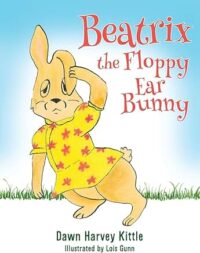Title: Beatrix the Floppy Ear Bunny
Author: Dawn Harvey Kittle
Illustrator: Lois Gunn
Publisher: Urlink Print & Media, LLC
ISBN: 978-1684865772
Pages: 28
Genre: Children’s Books
Reviewed by: Barbara Bamberger Scott
Hollywood Book Reviews
Author Dawn Harvey Kittle has created an engaging children’s story with an important message interwoven into the actions and reactions of its main animal characters.
The setting is a magical forest where all the animals can talk, possessing the same kinds of aspirations and attitudes as people do. There the reader meets a group of young friends. Charlie Chipmunk is hunting for nuts, hoping he tells his pals Betty and Billy Bunny that most of them have not been stolen by Sidney Squirrel as so often happens. The two bunnies then encounter their bunny friends Benjamin and Bertha who are carrying a picnic lunch of such delicacies as lettuce sandwiches and carrot juice. After munching, the bunnies play Blindman’s Bluff, with Ben being blindfolded while the others hide. When Ben tags someone, it is a bunny he has never seen before. She says her name is Beatrix. She is new in the forest; she wears a faded dress and one of her ears oddly flops over her face. The bunny bunch rejects her, mocking her clothing and her strange ear. Soon though, Beatrix becomes a member of their school class. Charlie Chipmunk wants to befriend her but would do so at the risk of losing all his bunny companions. Their teacher wants the bunnies to befriend the new student, but they are still reluctant. Then Betty and Billy learn something from their parents who have been hearing rumors about Beatrix and her lack of acceptance. What the children’s father and mother demonstrate to Betty and Billy will change their attitudes toward Beatrix, and lead to the newcomer’s newfound inclusion among the young magic forest animals.
Author Kittle is a retired schoolteacher and grandmother who has chosen to continue assisting youngsters through her lively books. The main theme of this brightly illustrated story indicates that Kittle intends to reach out to her young readers by offering significant, socially tinged and emotive messages embedded in a neatly constructed plot. This tale can be a read-to for preschoolers, while older children will read it on their own, inviting family and friendly discussion. Importantly, the book comes with a separate teacher’s manual available online, which will broaden the book’s usefulness by connecting with readers in educational settings. Kittle has undertaken an admirable task which demonstrates her talents in story-telling and her tenacity in helping children to learn – not only basic reading skills, but appropriate, vital communal skills which will be appreciated as they confront the wider world.

